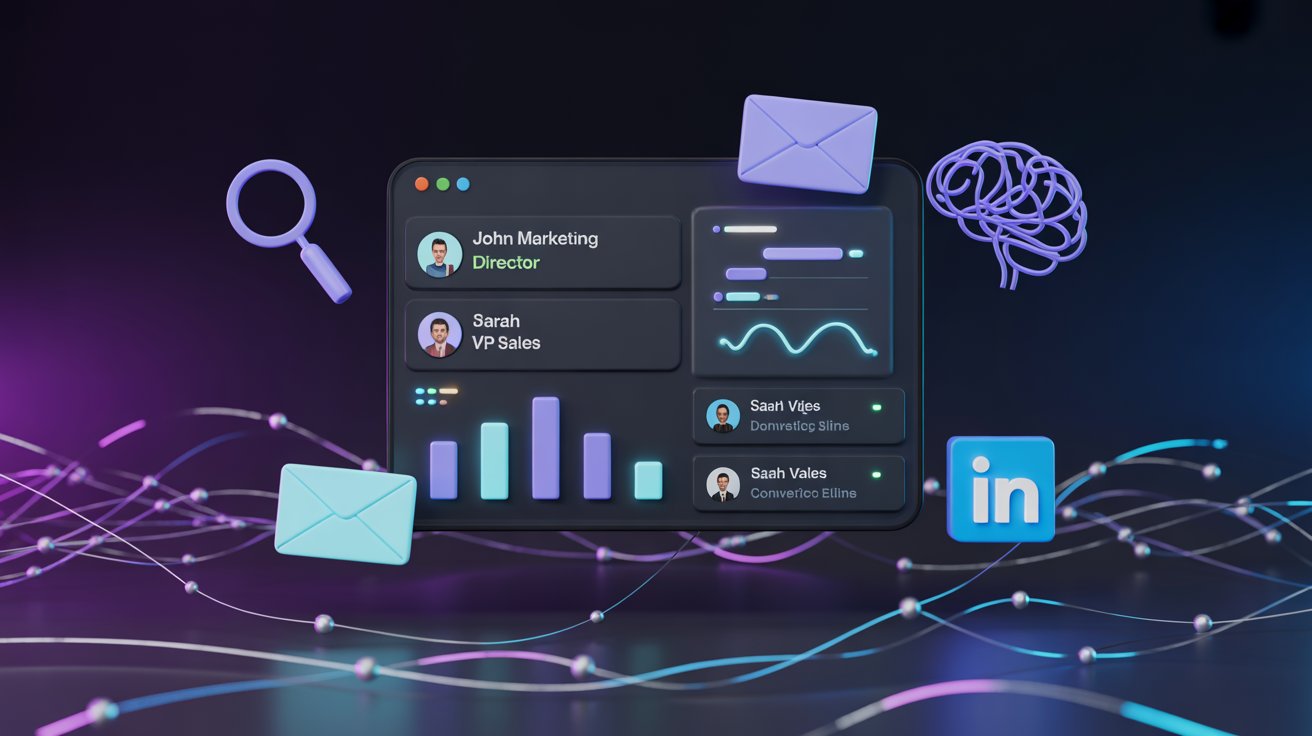Let me be honest with you. Finding quality leads is the lifeblood of any business. Without a steady stream of potential customers, even the best products struggle to survive.
That’s where lead generation tools come into play. These platforms help you identify, attract, and convert prospects into paying customers. Instead of cold-calling random contacts or sending mass emails to unqualified lists, modern lead generation tools let you target the right people at the right time.
The business landscape has changed dramatically. Today’s buyers do most of their research before ever talking to a sales rep. They’re smarter, more informed, and harder to reach through traditional methods.
This is especially true for B2B companies. That’s why modern businesses rely heavily on AI lead generation tools for smarter targeting and automation. These intelligent platforms analyze buyer behavior, predict intent, and help you personalize outreach at scale.
In this guide, I’ll break down the best B2B and AI-powered lead generation tools to help you find, attract, and convert leads faster. Whether you’re a solopreneur or managing a sales team, you’ll discover tools that fit your needs and budget.
What Are Lead Generation Tools?
Lead generation tools are software platforms designed to help businesses find and connect with potential customers. Think of them as your digital sales assistants working around the clock.
These tools serve multiple purposes. They automate data collection so you don’t waste hours searching for contact information manually. They help you find qualified leads who actually match your ideal customer profile. Plus, they nurture prospects through automated sequences until they’re ready to buy.
Here’s what makes them valuable. Instead of guessing who might be interested in your product, these platforms use data and signals to identify high-potential prospects. They verify contact details, track engagement, and even predict which leads are most likely to convert.
These B2B lead generation tools help businesses scale outreach and close more deals efficiently. You can reach hundreds or thousands of prospects while maintaining personalization. The best part? Everything integrates with your existing CRM and marketing stack.
Modern lead generation tools combine multiple functions. They find leads, enrich their data, manage their outreach campaigns, and track results all from one dashboard. This eliminates the need for juggling multiple subscriptions and disconnected workflows.
Why You Need Lead Generation Tools in 2025
The buyer journey has evolved significantly over the past few years. Today’s prospects interact with multiple touchpoints before making a purchase decision. They read reviews, compare alternatives, and seek peer recommendations online.
Manual lead generation simply can’t keep up with this pace. You need automation and AI to stay competitive. That’s where modern lead generation tools become essential for growth.
Let me break down the key benefits:
Save time and effort – Automation handles repetitive tasks like finding emails, sending follow-ups, and logging activities. Your team focuses on closing deals instead of administrative work.
Get verified contact data – No more bounced emails or wrong phone numbers. The best lead generation tools provide verified, up-to-date contact information for decision-makers.
Automate email and LinkedIn outreach – Set up multichannel sequences that run on autopilot. Prospects receive personalized messages across different platforms without manual intervention.
Integrate with CRM and marketing tools – Everything syncs seamlessly with platforms like HubSpot, Salesforce, and Pipedrive. Your data stays organized and accessible.
Here’s something interesting. Companies using AI lead generation tools see 35% higher conversion rates compared to traditional methods. Why? AI analyzes behavioral patterns and engagement signals to identify prospects with genuine buying intent.
The technology has become incredibly sophisticated. AI can now personalize messaging based on industry, company size, job role, and recent activities. It can also predict the best time to reach out and suggest optimal follow-up strategies.
Without the right tools, you’re essentially fighting with one hand tied behind your back. Your competitors are already using automation and AI to generate more leads with less effort.
Types of Lead Generation Tools
Not all lead generation tools serve the same purpose. Understanding different categories helps you build a complete tech stack. Let me walk you through the main types and what each one does.
Prospecting Tools
Prospecting tools help you discover potential customers and gather their contact information. These platforms maintain massive databases of company and contact data.
Tools like Apollo.io and ZoomInfo specialize in B2B prospecting. They provide verified email addresses, direct dial phone numbers, and detailed company insights. You can filter prospects by industry, company size, job title, location, and technology usage.
The best prospecting platforms also include buying intent signals. These indicators tell you when companies are actively researching solutions like yours. This timing advantage significantly improves your conversion rates.
Email Outreach Tools
Email outreach tools automate your cold email campaigns and follow-up sequences. They handle everything from sending emails to tracking opens, clicks, and replies.
Platforms like Instantly.ai, Smartlead, and Reply.io excel in this category. They offer features like email warmup, unlimited sending accounts, and deliverability optimization. You can create multi-step sequences that automatically follow up with prospects who don’t respond.
These tools also include A/B testing capabilities. You can test different subject lines, messaging angles, and call-to-actions to improve your response rates over time. If you want to automate your follow-ups and increase reply rates, I recommend checking out my full list of the best email outreach tools that simplify cold emailing for B2B teams.
LinkedIn Lead Generation Tools
LinkedIn has become the primary platform for B2B networking and prospecting. Lead generation tools automate your outreach on this platform.
Tools like Phantombuster and LinkedIn Sales Navigator help you at scale. They automate connection requests, send personalized messages, and engage with prospects’ content. Some even scrape profile data to build targeted lead lists.
However, automation must be done carefully to avoid LinkedIn restrictions. The best tools include safety features like daily limits and human-like behavior patterns.
AI-Powered Lead Scoring & Automation Tools
AI lead generation tools take prospecting to the next level. They use machine learning to score leads, predict conversion probability, and automate complex workflows.
Clay and HubSpot AI are perfect examples. These platforms enrich your lead data automatically, identify patterns in successful deals, and prioritize your hottest opportunities. They can even generate personalized outreach messages based on prospect data.
The AI continuously learns from your interactions. The more you use these tools, the smarter they become at identifying your ideal customers.
CRM & Lead Management Tools
CRM and lead management tools organize your prospect data and track interactions throughout the sales cycle. They ensure no lead falls through the cracks.
HubSpot CRM, Pipedrive, and Zoho are popular choices. These platforms manage your pipeline, automate task assignments, and provide visibility into team performance. Modern CRMs include built-in lead generation automation features like form builders, chatbots, and email tracking.
The right CRM becomes your single source of truth. Every conversation, email, and meeting gets logged automatically, giving you complete context for every prospect interaction.
13 Best Lead Generation Tools for 2025
I’ve tested dozens of platforms to bring you this curated list. These are the best lead generation tools that actually deliver results in 2025.
1. Apollo.io
Apollo.io is an all-in-one sales intelligence platform that combines prospecting, outreach, and engagement tools. It’s one of the most comprehensive B2B lead generation tools available today.
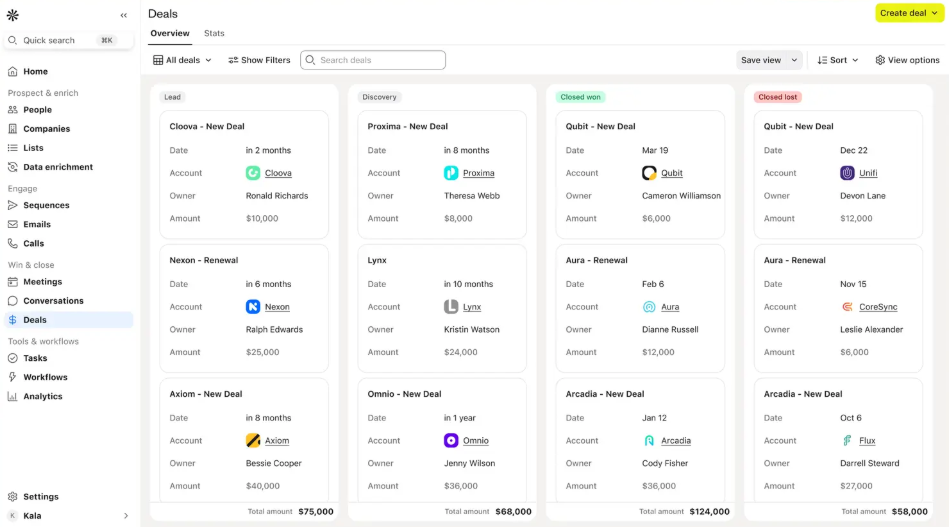
Key Features
- Access to 275+ million contacts and 73+ million companies
- Built-in email sequencing and automation
- Intent data and buying signals
- Chrome extension for prospecting on LinkedIn
- Native CRM integrations with Salesforce and HubSpot
- AI-powered email writing assistance
Pros
- Massive verified B2B database with high accuracy
- Unlimited email sequences across all paid plans
- Excellent Chrome extension for quick prospecting
- Strong deliverability features and email warmup
- Affordable pricing compared to competitors
Cons
- The credit system can be confusing for new users
- Learning curve for advanced features
- Some contact data requires verification
Pricing
- Free: $0 (1,200 credits/year, 2 sequences)
- Basic: $49/user/month (30,000 credits/year)
- Professional: $79/user/month (48,000 credits/year)
Best for: B2B sales teams, SDRs, and agencies needing prospecting and outreach in one platform.
2. ZoomInfo
ZoomInfo is the premium choice for enterprise-level sales intelligence. It offers the most comprehensive company and contact database with advanced intent data.
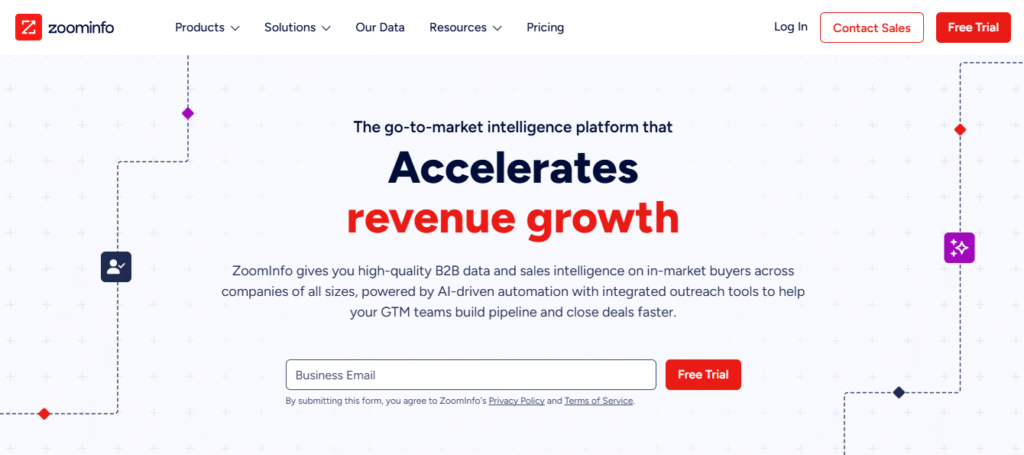
Key Features
- 200+ million professional contact profiles
- Advanced buyer intent signals and company insights
- Sales engagement platform with automated workflows
- Conversation intelligence and call recording
- Real-time alerts for job changes and company updates
- Deep integration with major CRM platforms
Pros
- Highest data accuracy among all providers
- Powerful intent data for identifying hot prospects
- Comprehensive technographic and firmographic filters
- Excellent for account-based marketing strategies
- Dedicated customer success support
Cons
- Premium pricing is not suitable for small businesses
- Requires annual contracts with custom pricing
- Steeper learning curve than simpler tools
Pricing
- Custom pricing (contact sales for quotes)
- Separate packages for Sales, Marketing, and Talent solutions
Best for: Enterprise sales teams, large marketing departments, and businesses with significant lead generation budgets.
3. Instantly.ai
Instantly.ai focuses purely on cold email automation at scale. It’s designed for businesses that want to send high-volume outreach without deliverability issues.
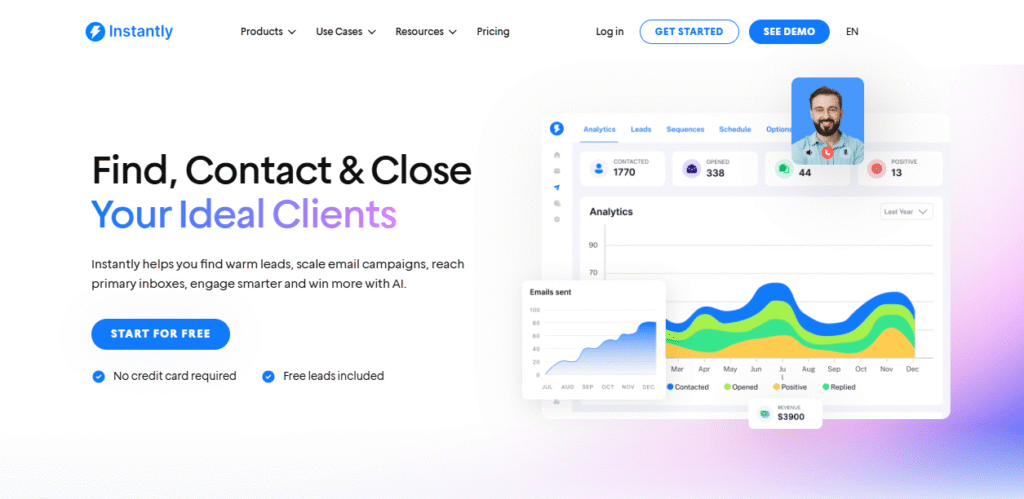
Key Features
- Unlimited email accounts and warmup
- Advanced deliverability optimization tools
- Email verification and list cleaning
- Campaign analytics and A/B testing
- Unibox for managing all replies in one place
- Integrations with popular CRMs
Pros
- Extremely affordable for high-volume sending
- Excellent email warmup technology
- No limits on email accounts across all plans
- Simple, user-friendly interface
- Great for agencies managing multiple clients
Cons
- No built-in prospecting database
- Limited multichannel capabilities (email-focused)
- Basic reporting compared to enterprise tools
Pricing
- Growth: $30/month (1,000 contacts, 5,000 emails/month)
- Hypergrowth: $77.6/month (25,000 contacts, 100,000 emails/month)
- Light Speed: $286.3/month (100,000 contacts, 500,000 emails/month)
Best for: Agencies, cold email specialists, and businesses focused on high-volume email outreach.
4. HubSpot
HubSpot is the most popular all-in-one CRM and marketing platform. It’s a free CRM that includes robust lead generation features, making it perfect for growing businesses.
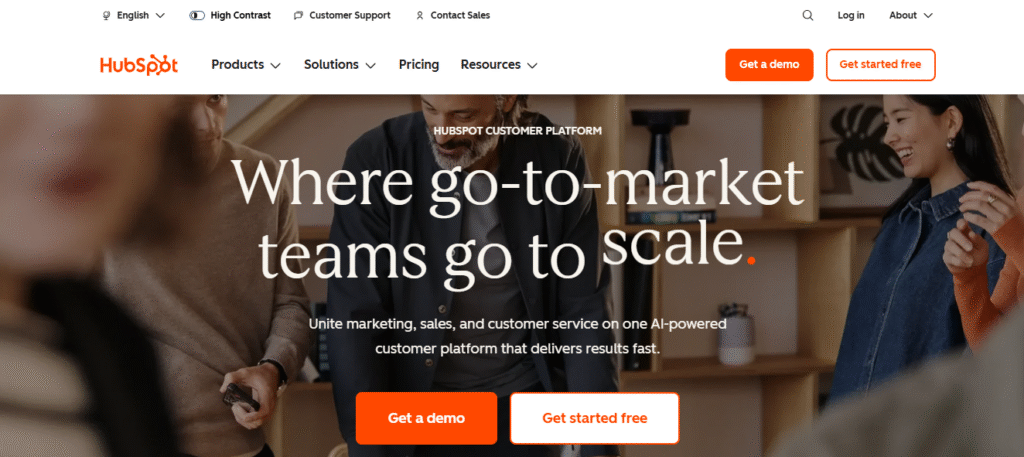
Key Features
- Free CRM with unlimited contacts and users
- Email marketing and automation tools
- Landing pages and form builders
- Live chat and chatbot functionality
- Marketing analytics and reporting
- Native integrations with 1,000+ apps
Pros
- Generous free plan with essential features
- User-friendly interface requires minimal training
- Seamless integration between marketing and sales tools
- Strong community and extensive learning resources
- Scales well from startup to enterprise
Cons
- Professional plans become expensive quickly
- Some advanced features require higher-tier subscriptions
- Reporting capabilities are limited on the lower tiers
Pricing
- Free: $0 (basic CRM and marketing tools)
- Starter: $9/user/month (500 HubSpot Credits, 1,000 marketing contacts)
- Professional: $800/month (includes 3 seats, advanced automation)
Best for: Small to medium businesses wanting an all-in-one marketing and sales platform with room to grow.
5. Clay
Clay is an AI-powered lead generation automation tool that enriches data from multiple sources. It’s the best AI lead generation tool for creating hyper-personalized outreach at scale.
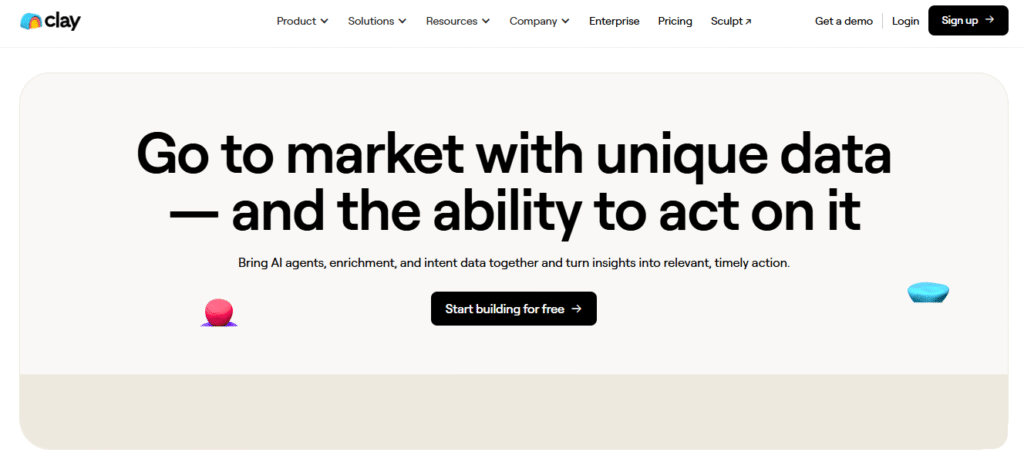
Key Features
- Integration with 100+ data providers
- AI-powered lead enrichment and scoring
- Automated workflows with conditional logic
- Claygent AI for web research and data extraction
- Real-time company and contact signals
- Export to any CRM or outreach tool
Pros
- Unmatched flexibility in data enrichment workflows
- Access to multiple data sources from one platform
- Powerful AI capabilities for personalization
- Unlimited users across all plans
- Great for creative, data-driven campaigns
Cons
- Steeper learning curve than traditional tools
- Credit-based pricing can get expensive
- Requires technical knowledge for advanced features
Pricing
- Free: $0 (limited features, 100 searches)
- Starter: $134/month (5,000 searches, AI credits included)
- Explorer: $314/month (10,000 searches, more AI credits)
- Pro: $720/month (25,000 searches, advanced features)
Best for: Data-savvy sales teams, growth hackers, and businesses focused on hyper-personalized outreach.
6. Lemlist
Lemlist specializes in personalized cold email and multichannel outreach. It’s one of the best B2B lead generation tools for creating engaging campaigns with high reply rates.
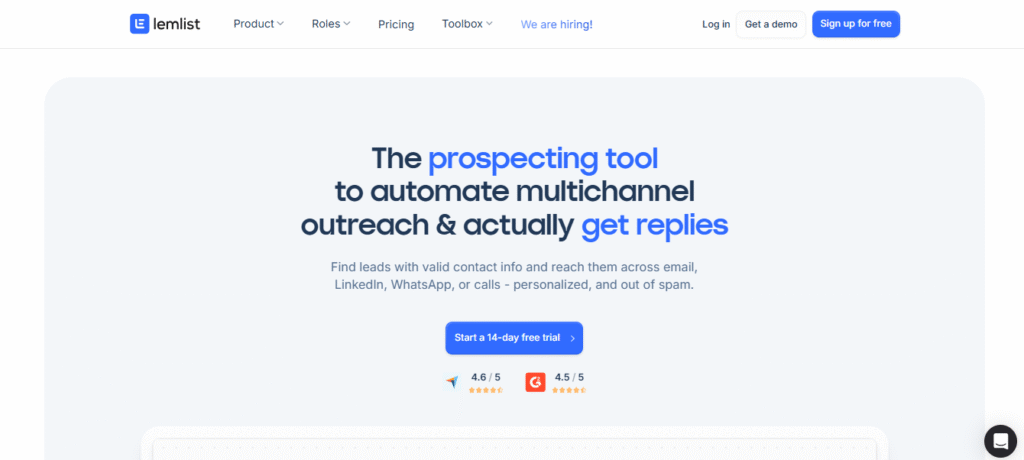
Key Features
- Multichannel sequences (email, LinkedIn, phone)
- AI-powered email personalization
- Built-in email warmup and deliverability tools
- Access to 600M+ B2B leads database
- Video prospecting and custom images
- Advanced A/B testing capabilities
Pros
- Excellent personalization features boost response rates
- User-friendly campaign builder
- Strong focus on deliverability optimization
- Good balance of features and affordability
- Active community and helpful support
Cons
- The database is not as comprehensive as ZoomInfo or Apollo
- LinkedIn automation requires a paid add-on
- Limited reporting on lower-tier plans
Pricing
- Email Pro: $55/user/month (1,000 enrichment credits, email outreach)
- Multichannel Expert: $79/user/month (1,500 credits, LinkedIn automation)
- Enterprise: Custom (5+ seats, advanced features)
Best for: Sales professionals and marketers who prioritize personalization and multichannel engagement.
7. Pipedrive
Pipedrive is a sales-focused CRM designed to help teams manage leads and close deals faster. It combines lead management with powerful automation features.
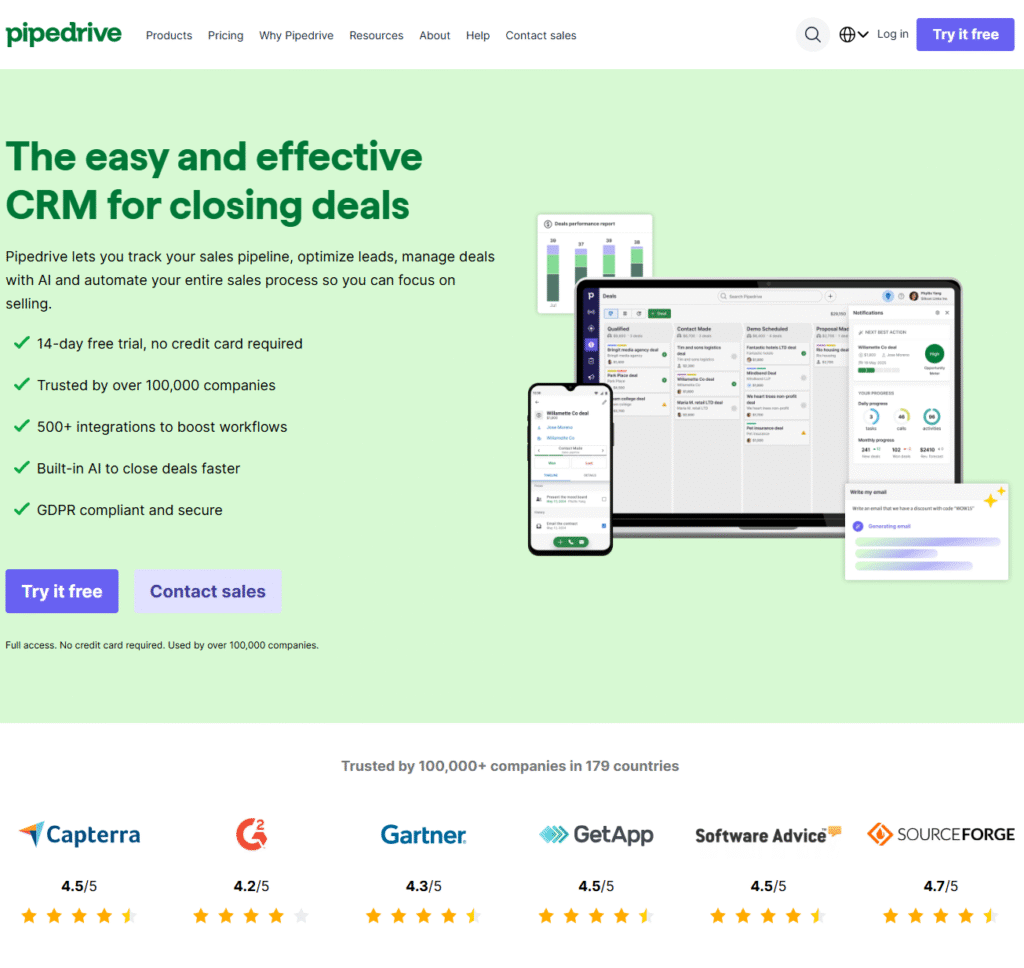
Key Features
- Visual sales pipeline management
- AI-powered sales assistant and insights
- Email sync with tracking and templates
- Lead generation and routing tools
- Meeting scheduler and calendar integration
- Custom reporting and forecasting
Pros
- Intuitive interface designed for salespeople
- Strong mobile app for on-the-go access
- Excellent pipeline visualization and deal tracking
- AI features help prioritize activities
- Affordable for small to medium teams
Cons
- Lead generation features require higher-tier plans
- Email marketing capabilities are less robust than HubSpot
- Limited native integrations compared to competitors
Pricing
- Lite: $14/user/month (basic pipeline management)
- Growth: $24/user/month (email automation, workflows)
- Premium: $49/user/month (lead generation, data enrichment)
- Ultimate: $69/user/month (advanced security, phone enrichment)
Best for: Sales teams focused on pipeline management and deal tracking rather than heavy prospecting.
8. Reply.io
Reply.io is a multichannel sales engagement platform that automates outreach across email, LinkedIn, calls, and SMS. It’s perfect for teams running complex outbound campaigns.
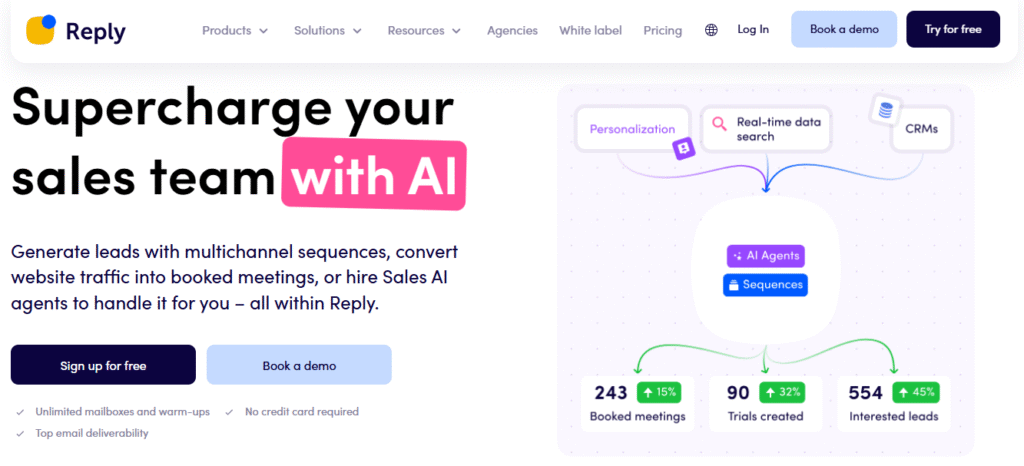
Key Features
- Multichannel sequences with email, LinkedIn, phone, SMS
- AI SDR (Jason AI) for automated prospecting
- Built-in dialer with call recording
- Email warmup and deliverability suite
- Live data enrichment credits
- CRM integrations and API access
Pros
- True multichannel automation in one platform
- Jason AI handles end-to-end prospecting automatically
- Flexible pricing models for different use cases
- Strong deliverability features included
- Excellent for high-touch sales processes
Cons
- LinkedIn and phone features cost extra
- The interface can feel overwhelming initially
- Higher learning curve than email-only tools
Pricing
- Email Volume: Starting at $159/month (10,000 contacts, unlimited users)
- Multichannel: Starting at $89/user/month (all channels included)
- Jason AI SDR: Starting at $500/month (fully automated)
Best for: B2B sales teams running sophisticated multichannel campaigns with personalized touchpoints.
9. Smartlead
Smartlead focuses exclusively on cold email deliverability and automation. It’s built for businesses sending high volumes while maintaining inbox placement.
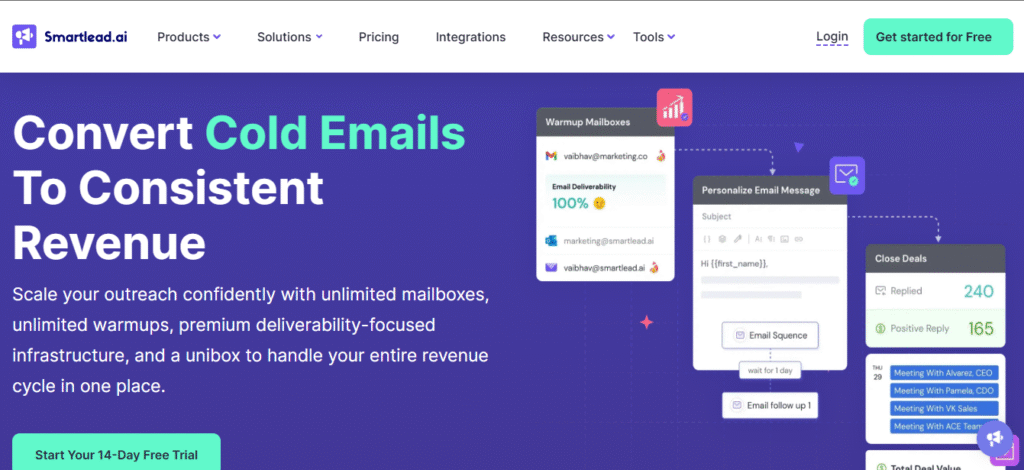
Key Features
- Unlimited email accounts and warmup
- Dynamic IP rotation for better deliverability
- Centralized master inbox for all replies
- AI-powered email writing with ChatGPT-4
- Detailed analytics and reporting
- Webhook integrations and API access
Pros
- Best-in-class email deliverability technology
- Unlimited mailbox connections across all plans
- Affordable pricing for high-volume senders
- Strong focus on avoiding spam folders
- Unlimited team seats on higher plans
Cons
- No built-in prospecting or lead database
- Email-only platform (no multichannel)
- Limited CRM integrations compared to competitors
Pricing
- Basic: $32.5/month (2,000 active leads, 6,000 emails/month)
- Pro: $78.3/month (30,000 leads, 150,000 emails/month, AI features)
Best for: Email marketing agencies and businesses prioritizing deliverability for cold email campaigns.
10. Hunter.io
Hunter.io is a simple yet powerful email finder and verification tool. It’s one of the best free lead generation tools for finding professional email addresses quickly.
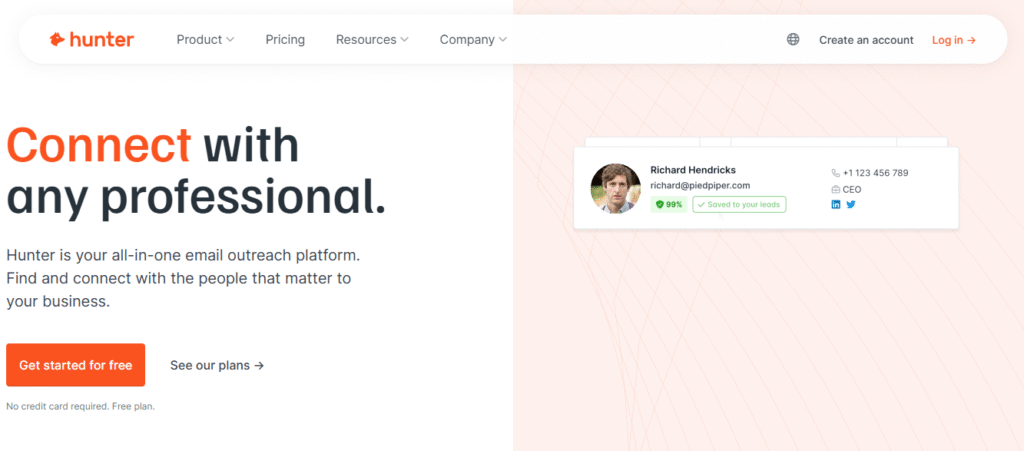
Key Features
- Domain search for finding company emails
- Email verification and validation
- Browser extension for LinkedIn prospecting
- Email campaigns and drip sequences
- AI writing assistant for email copy
- Lead enrichment with company data
Pros
- Simple, straightforward interface
- Generous free plan with 50 searches/month
- Highly accurate email finding and verification
- Affordable pricing for small teams
- Great Chrome extension for quick prospecting
Cons
- Limited to email finding (no phone numbers)
- Smaller database compared to enterprise tools
- Campaign features are less robust than specialized platforms
Pricing
- Free: $0 (50 credits/month, basic features)
- Starter: $34/month (24,000 credits/year, 3 email accounts)
- Growth: $104/month (120,000 credits/year, 10 accounts)
- Scale: $209/month (300,000 credits/year, 20 accounts)
Best for: Freelancers, startups, and small businesses needing affordable email finding and verification.
11. Snov.io
Snov.io is an all-in-one lead generation suite combining prospecting, email outreach, and CRM functionality. It offers exceptional value for money.

Key Features
- Email finder and LinkedIn prospecting tools
- Multichannel campaigns with email and LinkedIn
- Built-in sales CRM for deal tracking
- Email verification and deliverability tools
- AI-powered email builder with personas
- Unlimited prospect storage and export
Pros
- Comprehensive feature set at competitive prices
- Unlimited team seats on Pro plan
- Good balance of prospecting and outreach tools
- Strong email warmup and deliverability features
- Built-in CRM eliminates the need for a separate tool
Cons
- Interface feels less polished than premium alternatives
- LinkedIn automation quality varies
- Customer support can be slow during peak times
Pricing
- Starter: $29.25/month (1,000 credits, 5,000 recipients, 3 warmups)
- Pro: $74.25/month (5,000 credits, 25,000 recipients, unlimited warmups)
Best for: Budget-conscious teams wanting an all-in-one solution without multiple subscriptions.
12. Leadfeeder
Leadfeeder tracks website visitors and identifies companies viewing your content. It’s perfect for inbound lead generation and account-based marketing strategies.
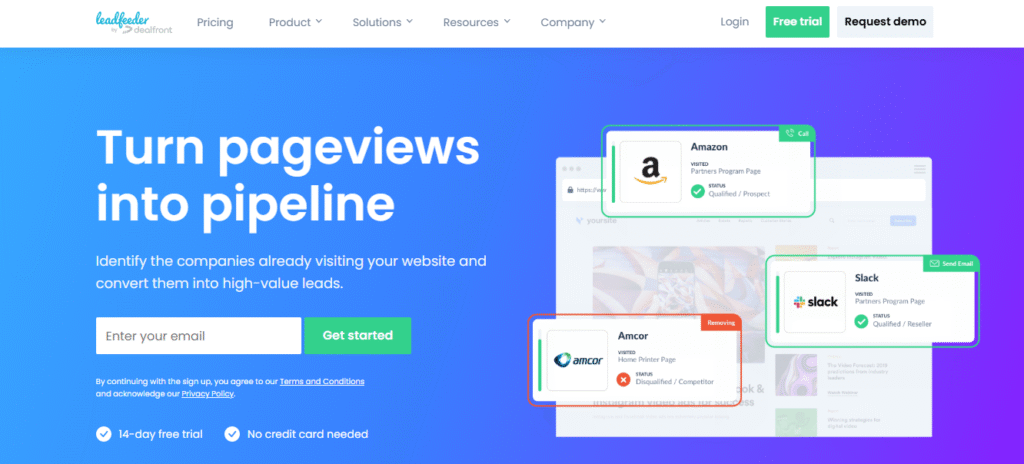
Key Features
- Website visitor tracking and identification
- Company firmographic data and contact info
- Integration with Google Analytics
- Custom lead scoring and filtering
- Real-time alerts for target accounts
- CRM sync with Pipedrive, HubSpot, Salesforce
Pros
- Reveals anonymous website visitors automatically
- Unlimited users on all plans, including free
- Easy setup with Google Analytics
- Great for identifying warm leads already interested
- Affordable pricing for SMBs
Cons
- Limited to companies visiting your website
- The free plan only shows 7 days of data
- Doesn’t provide individual contact information
Pricing
- Free: €0 (last 7 days data, max 100 companies)
- Paid: Starting at €99/month (unlimited storage, unlimited users)
Best for: Marketing teams focusing on inbound lead generation and website visitor intelligence.
13. Phantombuster
Phantombuster automates data extraction and outreach across multiple platforms, including LinkedIn, Twitter, Instagram, and more. It’s the most versatile automation tool for creative growth hackers.
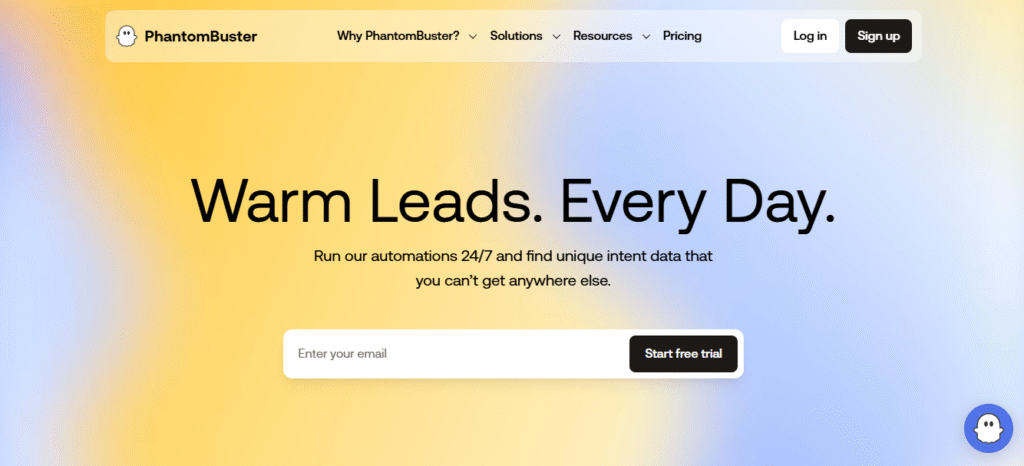
Key Features
- 100+ pre-built automation “Phantoms”
- LinkedIn, Twitter, Instagram, Facebook scraping
- Automated connection requests and messaging
- Email finding and enrichment
- API access for custom workflows
- Cloud-based execution (no browser needed)
Pros
- Incredible versatility across social platforms
- No coding required for most automations
- Creative use cases beyond typical lead generation
- Active community sharing automation strategies
- Transparent execution time pricing model
Cons
- Risk of account restrictions if used aggressively
- Requires careful configuration to avoid blocks
- Limited support for outreach campaigns
Pricing
- Free Trial: $0 (2h execution time, 1k AI credits)
- Starter: $56/month (20h execution, 10k AI credits, 5 Phantoms)
- Pro: $128/month (80h execution, 30k AI credits, 15 Phantoms)
- Team: $352/month (300h execution, 90k AI credits, 50 Phantoms)
Best for: Growth hackers, marketers, and businesses needing creative automation beyond standard lead generation.
How to Choose the Right Lead Generation Tool for Your Business
Selecting the right lead generation tools can feel overwhelming with so many options available. Let me help you narrow down your choices based on what actually matters.
Your Sales Cycle Length
Consider how long it typically takes to close deals. If you have a short sales cycle, you need tools that deliver leads quickly with minimal nurturing. Platforms like Hunter.io or Apollo.io work well here.
For longer B2B sales cycles, invest in comprehensive platforms with strong nurturing capabilities. Tools like HubSpot or Clay let you build complex, multi-touch sequences that maintain engagement over months.
Budget and Team Size
Be realistic about what you can afford long-term. Many businesses start with free tools like HubSpot CRM or Hunter.io’s free plan. As you grow, upgrade to paid tiers that match your lead volume needs.
Smaller teams benefit from all-in-one platforms that reduce software complexity. Larger teams might prefer specialized tools for each function. Calculate cost per lead to determine actual ROI, not just monthly subscription fees.
CRM Integration
Your lead generation tool must connect seamlessly with your existing CRM. Check integration capabilities before committing. Native integrations work better than third-party connectors like Zapier.
Most modern platforms integrate with popular CRMs like Salesforce, HubSpot, and Pipedrive. However, verify that data syncs bidirectionally and updates happen in real-time. Poor integration creates data silos that hurt your sales process.
AI and Automation Needs
Determine how much automation your process requires. Basic email sequences might suffice for simple outreach. Complex B2B sales processes benefit from AI lead generation tools that score prospects and personalize messaging automatically.
Consider your team’s technical capability too. Some AI tools require setup expertise, while others work out of the box. Match the tool’s complexity to your team’s skill level.
Looking for B2B lead generation tools that fit your workflow? Start with a free trial before committing. Most platforms offer 14-day trials that let you test features with real data. This hands-on experience beats any product demo.
Ready to transform your lead generation? Pick 2-3 tools from this guide and start your free trials today. You’ll quickly discover which platform feels right for your team’s needs and budget.
AI Lead Generation Tools: The Future of Prospecting
Artificial intelligence is revolutionizing how businesses find and engage prospects. AI lead generation tools have moved beyond simple automation to intelligent decision-making. According to Salesforce’s State of Sales report, 83% of high-performing sales teams use AI-powered tools
How AI Transforms Lead Generation
AI analyzes massive datasets to identify patterns humans would miss. It scores leads based on conversion probability using historical data from your past deals. The technology predicts which prospects are most likely to buy and when they’re ready to engage.
Unlike rule-based automation, AI continuously learns and improves. Every interaction teaches the system what works for your specific audience. This means your campaigns get smarter over time without manual optimization.
Key AI-Powered Features
Lead enrichment happens automatically as AI gathers data from dozens of sources simultaneously. Instead of manually researching each prospect, the system pulls company information, tech stack data, recent news, and social activity instantly.
Intent data reveals when companies actively research solutions like yours. AI monitors website visits, content downloads, and search patterns to identify buying signals. This timing advantage dramatically improves conversion rates.
Predictive scoring ranks your leads by likelihood to convert. The AI considers factors like company size, engagement history, budget signals, and behavioral patterns. Your team focuses energy on prospects with the highest success probability.
Automated outreach becomes truly personalized at scale. AI generates custom messages referencing specific details about each prospect’s company, role, and challenges. This level of personalization was impossible with traditional mail merge techniques.
Top AI Lead Generation Tools
Clay stands out for its flexibility in combining AI with multiple data sources. It lets you build custom enrichment workflows that pull information from anywhere and apply AI analysis automatically.
HubSpot AI integrates intelligence throughout the entire customer journey. From lead scoring to email optimization to content recommendations, the AI assists at every stage. It’s particularly strong for businesses already using HubSpot’s ecosystem.
Apollo.io combines a massive B2B database with AI-powered engagement tools. Its AI writes personalized emails, suggests optimal outreach times, and identifies accounts showing buying intent. The platform makes enterprise-grade AI accessible to smaller teams.
AI lead generation tools are transforming how B2B sales teams scale outreach efficiently. What once required large SDR teams can now be accomplished with smaller, more focused teams supported by intelligent automation.
The technology isn’t replacing salespeople—it’s making them dramatically more effective. Your team spends less time on research and repetitive tasks, and more time having meaningful conversations with qualified prospects.
Best Free and Affordable Lead Generation Tools
You don’t need a massive budget to start generating quality leads. Several excellent tools offer free plans or affordable pricing perfect for startups and small businesses.
Top Free Lead Generation Tools
HubSpot CRM provides the most comprehensive free plan in the industry. You get unlimited contacts, basic email automation, form builders, and live chat functionality. It’s genuinely free forever, not a limited trial. The platform scales beautifully as you grow, making it a safe long-term choice.
Hunter.io offers 50 free email searches per month. This might seem limited, but it’s perfect for targeted prospecting. The email verification feature ensures you’re not wasting time on invalid addresses. Upgrade to paid plans only when your volume increases.
Lemlist provides a 14-day free trial with full feature access. While not permanently free, this trial period gives you enough time to run a complete outreach campaign and evaluate results. Many users generate enough leads during the trial to justify the paid subscription. For a full breakdown, see my Lemlist review.
Smartlead also offers trial periods where you can test their deliverability technology. The Basic plan starts at just $32.50/month, making it one of the most affordable options for cold email at scale. Once you’ve built your prospect list, the next step is outreach. Don’t miss my full breakdown of the best cold email software to help you send personalized campaigns that actually land in inboxes.
Quick Comparison: Free vs. Paid Features:
| Tool | Free Plan | Starting Paid Plan | Best Feature |
|---|---|---|---|
| HubSpot CRM | Unlimited contacts, basic tools | $9/user/month | All-in-one platform |
| Hunter.io | 50 searches/month | $34/month | Email verification |
| Lemlist | 14-day trial | $55/user/month | Personalization |
| Smartlead | No free plan | $32.50/month | Deliverability |
| Apollo.io | 1,200 credits/year | $49/user/month | B2B database |
| Pipedrive | 14-day trial | $14/user/month | Sales CRM |
Making the Most of Free Tools
Start by combining multiple free tools to build a complete workflow. Use Hunter.io for finding emails, HubSpot CRM for managing contacts, and free trial periods of outreach tools for campaigns.
Focus on quality over quantity when working with limited credits. Research prospects thoroughly before using your searches. Target your ideal customer profile precisely rather than casting a wide net.
Leverage free trials strategically. Sign up when you’re ready to launch a campaign, not just to browse features. This maximizes the value you extract from the trial period.
Start with a free B2B lead generation tool and scale up as your business grows. Many successful companies began with free plans and only upgraded once they proved their lead generation ROI. There’s no shame in starting small—every enterprise company started somewhere.
Ready to get started? Pick a free tool from this list and set up your first campaign today. You’ll be generating qualified leads within hours, not weeks.
Common Mistakes to Avoid When Using Lead Generation Tools
Even the best lead generation tools won’t deliver results if you’re making critical mistakes. Let me help you avoid the most common pitfalls I’ve seen businesses make.
Over-Relying on Automation
Automation is powerful, but it shouldn’t replace human judgment entirely. I’ve seen teams send thousands of generic automated messages that get zero responses. The key is balancing automation with personalization. Use tools to handle repetitive tasks, but always add human touches to your outreach. Review your automated sequences regularly and adjust based on response rates. Remember, your prospects can tell when they’re talking to a robot.
Not Verifying Contact Data
Sending emails to invalid addresses destroys your sender reputation. Many businesses upload lists without verification and wonder why their deliverability tanks. Always use email verification features before launching campaigns. Tools like Hunter.io and Apollo.io include built-in verification. This extra step saves your domain reputation and improves campaign performance. Bad data wastes credits and damages your brand. Before launching any campaign, make sure your emails are valid. You can explore the best email verification tools I’ve tested to reduce bounces and protect your sender reputation.
Ignoring GDPR and Compliance Rules
Data privacy regulations aren’t optional. Sending unsolicited emails to EU contacts without proper consent can result in massive fines. Make sure your lead generation tools comply with GDPR, CAN-SPAM, and local regulations. Include clear opt-out options in every message. Store consent records properly. Compliance protects your business and builds trust with prospects.
Not Integrating CRM or Follow-Up Sequences
Disconnected tools create chaos. When your lead generation platform doesn’t sync with your CRM, leads fall through the cracks. Set up proper integrations from day one. Build comprehensive follow-up sequences that nurture prospects over time. One-off emails rarely convert. Map out a multi-touch strategy that guides leads through your sales funnel systematically.
Avoiding these lead generation strategy mistakes will dramatically improve your results. Take time to optimize lead generation tools properly rather than rushing into campaigns. The setup work pays off exponentially over time.
Final Thoughts
Lead generation has transformed dramatically over the past few years. The manual processes of cold calling random lists and sending mass emails are dead. Today’s successful businesses leverage AI and automation to identify, engage, and convert prospects efficiently.
The best lead generation tools I’ve covered in this guide represent the cutting edge of sales technology. From AI-powered platforms like Clay and Apollo.io to specialized solutions like Instantly.ai and Lemlist, there’s a tool for every budget and business model.
You don’t need to implement everything at once. Start by identifying your biggest lead generation challenge. Need more prospects? Try Apollo.io or ZoomInfo. Struggling with email deliverability? Test Smartlead or Instantly.ai. Want better personalization? Explore Lemlist or Clay.
The key is taking action. Every day you delay implementing these AI lead generation tools is a day your competitors get ahead. Most platforms offer free trials, so there’s no risk in testing multiple options.
I encourage you to choose 2-3 tools from this list and run parallel tests. You’ll quickly discover which platform fits your workflow and delivers the best ROI for your specific situation.
Ready to grow your sales pipeline? Start testing these B2B lead generation tools today! The future of prospecting is here, and it’s more accessible than ever. Your next wave of customers is waiting to be discovered.
FAQs
1: What are the best B2B lead generation tools in 2025?
The best B2B lead generation tools in 2025 include Apollo.io for all-in-one prospecting, ZoomInfo for enterprise sales intelligence, and Clay for AI-powered enrichment. HubSpot excels at combining CRM with marketing automation, while Instantly.ai and Smartlead dominate cold email deliverability. Your ideal choice depends on your budget and needs. Most successful teams combine 2-3 specialized tools rather than relying on one platform. I also cover an in-depth Smartlead AI, Apollo.io, Instantly.ai review here.
2: How do AI lead generation tools work?
AI lead generation tools use machine learning to automate prospecting and personalization. They analyze your past deals to score new leads by conversion probability. The AI enriches data automatically from multiple sources, monitors intent signals to predict buying readiness, and generates personalized messaging based on each prospect’s role and company. This technology eliminates manual research while improving targeting accuracy and response rates.
3: Are there any free lead generation tools for small businesses?
Yes! HubSpot CRM offers unlimited contacts, email automation, and forms completely free. Hunter.io provides 50 free email searches monthly with verification. Apollo.io includes a free plan with 1,200 annual credits. These tools give startups enough functionality to start generating leads immediately without any investment.
4: What’s the difference between B2B and B2C lead generation tools?
B2B tools target business decision-makers using firmographic data, LinkedIn networks, and longer nurturing sequences for complex sales cycles. B2C tools focus on individual consumers through Facebook and Instagram, using demographic data for faster conversions and impulse purchases. B2B emphasizes relationship-building and account-based approaches, while B2C prioritizes volume and speed.

